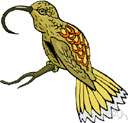un·cus
(ŭng′kəs)n. pl. un·ci (ŭn′sī) Biology
A hook-shaped part or process.
[Latin, hook.]
American Heritage® Dictionary of the English Language, Fifth Edition. Copyright © 2016 by Houghton Mifflin Harcourt Publishing Company. Published by Houghton Mifflin Harcourt Publishing Company. All rights reserved.
uncus
(ˈʌŋkəs)n, pl unci (ˈʌnsaɪ)
1. (Zoology) zoology anatomy a hooked part or process, as in the human cerebrum
2. (Anatomy) zoology anatomy a hooked part or process, as in the human cerebrum
[C19: from Latin: hook]
Collins English Dictionary – Complete and Unabridged, 12th Edition 2014 © HarperCollins Publishers 1991, 1994, 1998, 2000, 2003, 2006, 2007, 2009, 2011, 2014
un•cus
(ˈʌŋ kəs)n., pl. un•ci (ˈʌn saɪ)
any hook-shaped body part or process.
[1820–30; < New Latin, Latin: literally, hook]
Random House Kernerman Webster's College Dictionary, © 2010 K Dictionaries Ltd. Copyright 2005, 1997, 1991 by Random House, Inc. All rights reserved.
ThesaurusAntonymsRelated WordsSynonymsLegend:
| Noun | 1. |  uncus - (biology) any hook-shaped process or part uncus - (biology) any hook-shaped process or partbiological science, biology - the science that studies living organisms |
Based on WordNet 3.0, Farlex clipart collection. © 2003-2012 Princeton University, Farlex Inc.